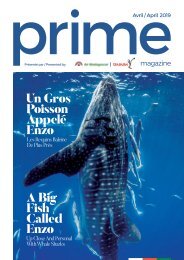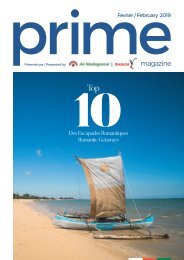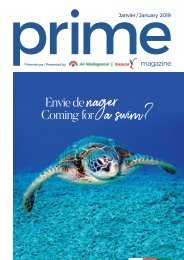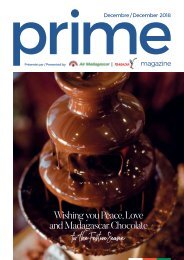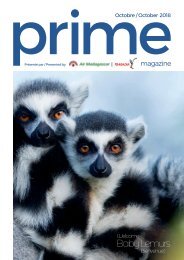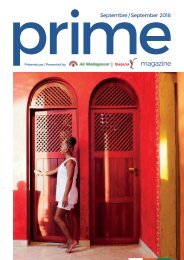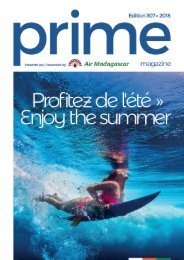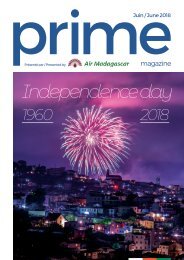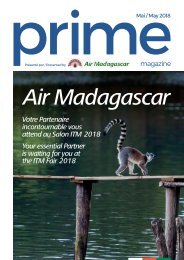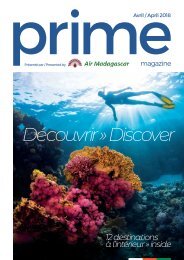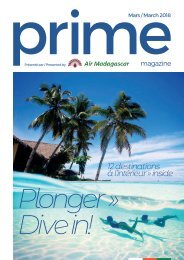PRIME MAG - AIR MAD - MARCH 2019 - SINGLE PAGES - LO-RES
Create successful ePaper yourself
Turn your PDF publications into a flip-book with our unique Google optimized e-Paper software.
BIODIVERSITY<br />
Faune<br />
Le Microcèbe<br />
de Madame<br />
Berthe<br />
L<br />
e lémurien minuscule doit son nom à la<br />
conversationniste et primatologue Berthe<br />
Rakotosamimanana. Avec son allure de souris, il<br />
ne mesure qu’environ 10 cm et ne pèse que 30g,<br />
un poids qui varie selon les saisons.<br />
On le reconnaît à sa fourrure bicolore cannelle et brun<br />
grisâtre, et à sa tête plus colorée. Ce petit animal nocturne,<br />
se nourrit de fruits, de fleurs et de petits vertébrés. Il se<br />
reproduit une fois par an, en novembre.<br />
Le microcèbe Madame Berthe vit dans la région de<br />
Menabe, au sud-ouest de la rivière de Tsiribihina. Il s’abrite<br />
dans les forêts sèches de Kirindy et d’Ambadira ainsi que<br />
dans les forêts du nord-ouest d’Analabe.<br />
La vie de ce primate est rendue très vulnérable par la<br />
dégradation de son habitat, l’intrusion humaine et par<br />
les prédateurs qui s’en prennent à sa petite taille. Il est<br />
donc classé en « danger critique d’extinction » par l'Union<br />
internationale pour la conservation de la nature (UICN).<br />
Fauna<br />
Madame<br />
Berthe's<br />
Mouse Lemur<br />
This little lemur owes its name to the<br />
conservationist and primatologist Berthe<br />
Rakotosamimanana. Similar to a mouse, the<br />
average body length is only around 9 to 11cm<br />
with a seasonal weight of 30g.<br />
It is distinguished by its two-tone cinnamon fur and a<br />
touch of greyish brown, but its face is more colourful. This<br />
little animal is nocturnal, and feeds on fruits, flowers,<br />
small vertebrates. It reproduces once a year in November.<br />
The Madame Berthe'S Mouse Lemur is found in the<br />
Menabe region, in the south-west of the Tsiribihina River,<br />
sheltered in the dry forests of Kirindy and Ambadira, and<br />
in the north-western forests of Analabe.<br />
This primate is highly vulnerable to habitat<br />
degradation, human intrusion, and predators due to<br />
its small size and therefore classified as "Critically<br />
Endangered" by the International Union for Conservation<br />
of Nature (IUCN).<br />
Prime remercie WWF pour l'élaboration de ce texte et les photos.<br />
Suite à notre article du mois d'octobre sur le "Poisson scie", nous tenons<br />
à vous informer que cet article est tiré des résultats des recherches<br />
effectuées par Dr. Ruth Leeney, les seules informations disponibles à<br />
Madagascar sur l’espèce proprement dite.<br />
Prime thanks WWF for developing this text and pictures.<br />
Following our October article on "Sawfish", we would like to inform you that<br />
this article is based on the results of Dr. Ruth Leeney's research, the only<br />
information available in Madagascar on the species itself.<br />
| 52 | Magazine online www.primemedia.international



